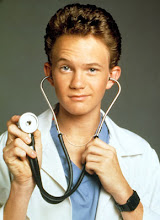Well, the week-long "Medical Spanish" workshop I took during med school was clearly not enough.
My mistake is pretending, because then for eight seconds the patient thinks I actually speak Spanish and starts talking to me, and all I can do is shrug and nod. I can say hello, I can say goodbye, and I can say doctor. I can say I don't speak Spanish, which is helpful.
I find it amusing that the one procedure that transcends the language barrier is in fact the pelvic exam, because all of those words are pretty much the same in English as in Spanish. The face, nothing is the same-- la cabeza, la cara, la garganta, la boca, el cuello-- if you don't know these words, you can't really figure it out except by pointing. But la pelvis, el utero, los ovarios, el cervix, la vagina -- that's all pretty straightforward. (Similarly on the men's side-- la prostata, los testiculos, el pene.)
So someone starts telling me about pain in las costillas, I'm pretty clueless, a problem with la vejiga, I need a translator. But if his penis hurts, well, now we can do business, I'm totally on board.
The problem with the medical spanish class is that you end up with a script-- breathe deeply, squeeze my fingers, stick out your tongue, does it hurt-- and even if you memorize all of that, you're still not going to understand the responses. Patients don't talk back from a script. They say all kinds of things, some of which are important, and unless you're actually fluent, you're not going to catch everything-- and then to add tone of voice to the equation, it's impossible to learn this stuff from flash cards. At least in the outpatient setting, a good number of patients aren't just sitting down and telling you what the problem is. They may think they know what the problem is, but it isn't until you get a bit of the patient history and start asking the right questions that you really know the whole story. I had a patient yesterday who came in with a particular issue, and as he started talking I noticed he had a tremor in one of his limbs, and so I started asking questions about that-- questions he didn't really care about, because in his mind they were irrelevant, he was there for something unrelated, so why did I keep asking about this other thing-- and eventually we figured out there's all sorts of medication interactions going on and his real issue is a different one than what he came in thinking he was supposed to talk about.
It's hard enough to find the source of some of these problems when you and the patient are both speaking the same language. But when neither of you understands the other, it's impossible. We have translator phones-- you call a number, someone gets on and translates back and forth-- but it's not an ideal situation, and the translator isn't in the room, can't really engage with the patient, can't always make sense of what the patient is really talking about-- and the translator doesn't always have the medical knowledge to help make things clearer, of course. It's better than nothing-- but even better would be if I spoke the same language as the patient.
I don't know that there's much of a solution-- you can't expect doctors to know how to speak every language a hypothetical patient might speak, and it's unrealistic and unfair to expect every patient to be able to speak fluent English-- so we muddle through.
And at least in the case of pelvic exams, hey, it all works out just fine.
Friday, September 11, 2009
Subscribe to:
Post Comments (Atom)

Now you didn't actually expect to become proficient in medical Spanish is a week, did you? Here's another resource for you:
ReplyDeletehttp://www.medicalspanish.com/